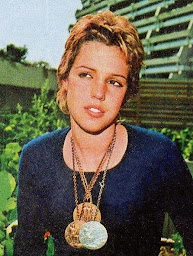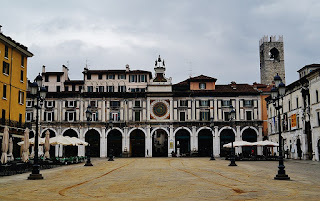Elsa Martinelli – actress
Tuscan beauty was spotted by Kirk Douglas
Actress and former model Elsa Martinelli was born Elisa Tia on this day in 1935 in Grosseto. She moved to Rome with her family as a teenager and was discovered by designer Roberto Capucci in 1953 while working as a barmaid in the city. Her stunning looks helped her to become a successful fashion model and she eventually began playing small parts in films. As Elsa Martinelli she appeared in Claude Autant-Lara’s Le Rouge et Le Noir in 1954. Her first important role came a year later when Kirk Douglas is said to have seen her on a magazine cover and told his production company to hire her to appear opposite him in the film, The Indian Fighter. In 1956 she won the Silver Bear for Best Actress at the Berlin Film Festival for playing the title role in Mario Monicelli’s Donatella. Martinelli married Count Franco Mancinelli Scotti di San Vito and they had a daughter, Cristiana, in 1958. Ten years later, after she had split up with her first husband, Martinelli married photographer and furniture designer Willy Rizzo. In the 1950s and 1960s she attended lavish parties and events in Rome with celebrities. Read more…
______________________________________________________________
Carlo Maderno - architect
Facade of St Peter's among most notable works
The architect Carlo Maderno, who has been described as one of the fathers of Italian Baroque architecture, died on this day in 1629 in Rome. His most important works included the facades of St Peter’s Basilica and the other Roman churches of Santa Susanna and Sant’ Andrea della Valle. Although most of Maderno's work was in remodelling existing structures, he had a profound influence on the appearance of Rome, where his designs also contributed to the Palazzo Quirinale, the Palazzo Barberini and the papal palace at Castel Gandolfo. One building designed and completed under Maderno's full control was the church of Santa Maria della Vittoria in the Sallustiano district. Maderno was born in 1556 in the village of Capolago, on the southern shore of Lake Lugano in what is now the Ticino canton of Switzerland, part of the finger of Italy's northern neighbouring country that extends between the Italian lakes Como and Maggiore. Marble was quarried in the mountains around Capolago and as well as a talent for sculpture he had experience as a marble cutter when he moved with four of his brothers to Rome in 1588 to work with his uncle, Domenico Fontana. Read more…
_________________________________________________________
Bernardo Bellotto – landscape painter
Venetian artist blessed with uncle Canaletto’s talent
The landscape artist Bernardo Bellotto, a nephew and pupil of the masterful view painter Canaletto, was born on this day in 1721 in Venice, the city that brought fame to his illustrious uncle. Bellotto painted some Venetian scenes but travelled much more extensively than his uncle and eventually became best known for his work in northern Europe, and in particular his views of the cities of Vienna, Warsaw and Dresden. His work was notable for his use of light and shadow and his meticulous attention to detail. His paintings of Warsaw became a point of reference for architects involved with the reconstruction of the city after the Second World War, so precise was he in terms of perspective and scale and the intricacies of architectural features. Born in the parish of Santa Margherita in Venice, Bellotto was related to Giovanni Antonio Canal – Canaletto’s birth name – through his mother, Canaletto’s sister, Fiorenza Canal, who married Lorenzo Antonio Bellotto. It was natural for Bernardo to study in his uncle’s workshop and to an extent mimic Canaletto’s style. Sometimes, he would sign a painting with Canaletto’s name, which led to confusion later. Read more…
__________________________________________________________
Feast of Saint Martina of Rome
The day Pope Urban VIII’s own hymns are sung
The feast day of Saint Martina of Rome, who was martyred by the Romans in 228, is celebrated every year on this day. Martina is now a patron saint of Rome and the patron saint of nursing mothers. She was the daughter of an ex-consul, one of the chief magistrates of the Roman Republic, but became an orphan while still young. Described at the time as a noble and beautiful virgin who was charitable to the poor, she openly testified to her Christian faith. She was persecuted during the reign of Emperor Alexander Severus and arrested and commanded to return to idolatry, the worship of false gods. When she refused she was whipped and condemned to be devoured by wild beasts in the amphitheatre. When she was miraculously untouched by the animals she was thrown on to a burning pyre from which she is also said to have escaped unhurt. Finally she was beheaded. Afterwards it was claimed some of her executioners converted to Christianity and were also later beheaded. In 1634 the relics of Martina were rediscovered by the artist Pietro da Cortona. They were in the crypt of a church originally built in the sixth century on the site of the ancient temple of Mars. Read more…
____________________________________________________________
Hyacintha Mariscotti – Saint
Noblewoman gave up luxurious lifestyle to help the poor
Hyacintha Mariscotti, an Italian nun of the Third Order Regular of Saint Francis, died on this day in 1640 in Viterbo in Lazio. Pope Pius VII canonised her in 1807 and her feast day is now celebrated on 30 January every year. Hyacintha, known as Santa Giacinta Marescotti in Italian, was born in 1585 into a noble family living in the castle of Vignanello in the province of Viterbo and was baptised as Clarice. Her father was Count Marcantonio Marescotti, her mother Countess Ottavia Orsini, whose father built the famous gardens of Bomarzo. The young Clarice was sent with her sisters to the monastery of Saint Bernardino to be educated by the nuns of the Franciscan Third Order Regular. When their education was complete, her elder sister, Ginevra, chose to enter the community as a nun. Clarice had set her sights on marrying the Marchese Capizucchi, but he chose her younger sister, Ortensia, instead. Following her disappointment, she entered the monastery at Viterbo taking the name Hyacintha (Giacinta). She admitted later that she did this only because she was upset and was not prepared to give up the luxuries she was used to. Read more…


















